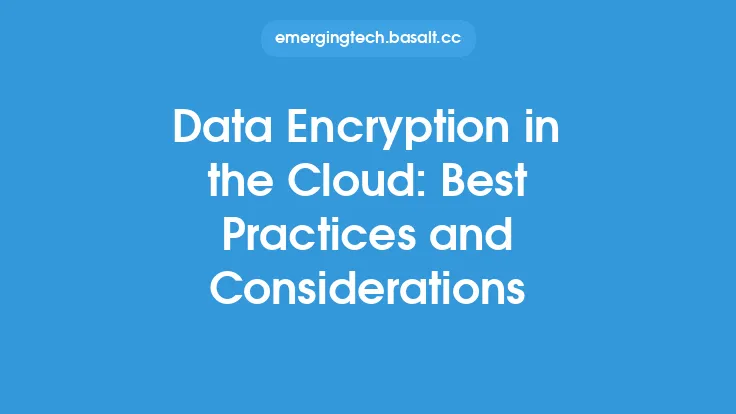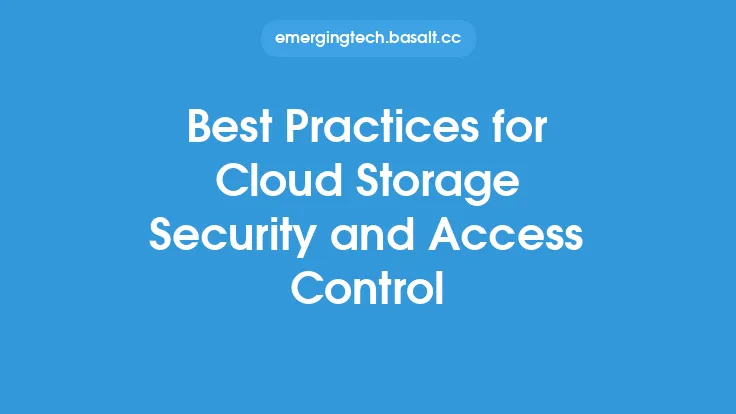Cloud native applications are designed to take advantage of the scalability, flexibility, and resilience of cloud computing environments. However, this also introduces new security challenges that must be addressed to protect sensitive data and ensure the integrity of the application. In this article, we will explore the best practices for securing cloud native applications, focusing on the key principles and techniques that can help organizations ensure the security and compliance of their cloud-based systems.
Introduction to Cloud Native Application Security
Cloud native application security is a critical aspect of cloud computing, as it involves protecting the application, its data, and the underlying infrastructure from various types of threats. Cloud native applications are built using a microservices architecture, which means that they consist of multiple, independent services that communicate with each other using APIs. This architecture introduces new security challenges, such as the need to secure multiple endpoints, manage identity and access, and ensure the integrity of data in transit.
To address these challenges, organizations must adopt a comprehensive security strategy that includes multiple layers of protection, including network security, application security, and data security. This strategy must also take into account the unique characteristics of cloud native applications, such as their scalability, flexibility, and use of cloud-based services.
Security Principles for Cloud Native Applications
There are several key security principles that organizations should follow when building and deploying cloud native applications. These principles include:
- Least privilege access: This principle involves granting users and services only the privileges they need to perform their tasks, and no more. This helps to reduce the attack surface and prevent unauthorized access to sensitive data.
- Defense in depth: This principle involves using multiple layers of protection to secure the application and its data. This can include firewalls, intrusion detection systems, encryption, and access controls.
- Security as code: This principle involves integrating security into the application development process, using tools and techniques such as continuous integration and continuous deployment (CI/CD) pipelines, and infrastructure as code (IaC) tools.
- Monitoring and logging: This principle involves continuously monitoring the application and its infrastructure for security threats, and logging all security-related events to detect and respond to incidents.
Securing Cloud Native Application Infrastructure
Cloud native applications rely on a complex infrastructure that includes multiple services, such as compute, storage, and networking. To secure this infrastructure, organizations must follow several best practices, including:
- Using secure protocols for communication: This includes using HTTPS for communication between services, and encrypting data in transit using protocols such as TLS.
- Implementing network segmentation: This involves dividing the network into multiple segments, each with its own access controls and security policies.
- Using cloud security groups: This involves using cloud-based security groups to control access to resources, such as virtual machines and storage buckets.
- Monitoring infrastructure logs: This involves continuously monitoring infrastructure logs to detect security threats and respond to incidents.
Securing Cloud Native Application Data
Cloud native applications handle large amounts of sensitive data, including personal identifiable information (PII), financial data, and confidential business information. To secure this data, organizations must follow several best practices, including:
- Encrypting data at rest: This involves encrypting data stored in databases, file systems, and other storage systems.
- Encrypting data in transit: This involves encrypting data as it is transmitted between services, using protocols such as TLS.
- Using secure data storage: This involves using secure data storage systems, such as encrypted storage buckets and databases.
- Implementing access controls: This involves implementing access controls, such as authentication and authorization, to control access to sensitive data.
Securing Cloud Native Application Services
Cloud native applications consist of multiple services, each with its own security requirements. To secure these services, organizations must follow several best practices, including:
- Using secure communication protocols: This includes using HTTPS for communication between services, and encrypting data in transit using protocols such as TLS.
- Implementing service-level access controls: This involves implementing access controls, such as authentication and authorization, to control access to services.
- Monitoring service logs: This involves continuously monitoring service logs to detect security threats and respond to incidents.
- Using secure service discovery: This involves using secure service discovery mechanisms, such as DNS and load balancers, to manage service communication.
Implementing Cloud Native Application Security Tools
There are several cloud native application security tools that organizations can use to secure their applications and data. These tools include:
- Cloud security platforms: These platforms provide a comprehensive set of security tools and services, including threat detection, incident response, and compliance management.
- Container security tools: These tools provide security for containerized applications, including vulnerability scanning, compliance management, and runtime security.
- Serverless security tools: These tools provide security for serverless applications, including function-level security, data encryption, and access controls.
- Cloud-based identity and access management (IAM) tools: These tools provide secure identity and access management for cloud native applications, including authentication, authorization, and access controls.
Conclusion
Cloud native application security is a critical aspect of cloud computing, as it involves protecting sensitive data and ensuring the integrity of the application. To secure cloud native applications, organizations must adopt a comprehensive security strategy that includes multiple layers of protection, such as network security, application security, and data security. This strategy must also take into account the unique characteristics of cloud native applications, such as their scalability, flexibility, and use of cloud-based services. By following the best practices outlined in this article, organizations can ensure the security and compliance of their cloud native applications, and protect their sensitive data from various types of threats.





